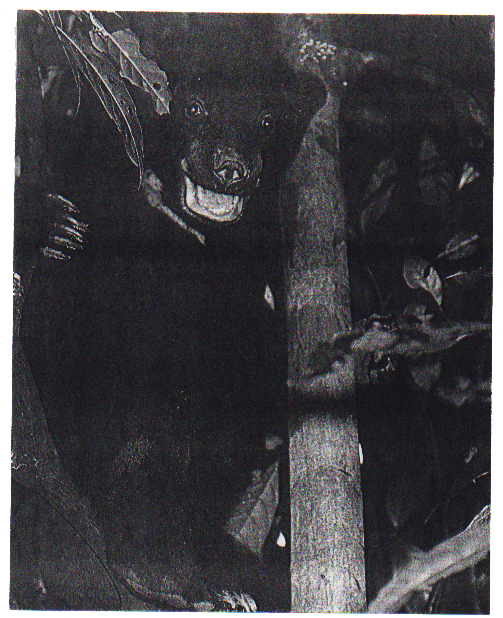 Marshall
Cultural Atlas Marshall
Cultural Atlas
This collection of student work is from
Frank Keim's classes. He has wanted to share these works for others
to use as an example of Culturally-based curriculum and documentation. These
documents have been OCR-scanned. These are available
for educational use only.

SUN BEAR
SUN BEAR
There are two species of bears that occur South of the Equator,
the Spectacled bear and the Sun bear. The Sun bear is the world's
smallest bear and lives in the remains of the tropical forests of the
Malay Peninsula, Java, Sumatra, Burma, and Thailand. The scientific
name for the Sun bear is Helarctos malayanus.
The Sun bear gets its name from the yellowish crescent on its
chest. In some areas of their range, Sun bears are known as Honey
bears or Malay bears. They weigh between 60 and 143 pounds. This
smallest member of the bear family grows to only about 45 feet in
length. Wild Sun bears weigh over 110 pounds. The Sun bear is covered
with short, dense, black fur. It lives in the jungles of the tropics.
If I traveled through the jungle, when I emerged I would be smeared
with dirt and sweat from head to toe. But if a Sun bear went through
the jungle the same way, the bear would come out spotless. This is
because of the smooth quality of the fur.
This sleek animal's muzzle may vary from grayish white to orange
in color. It has small, rather beady eyes and small rounded ears. The
feet, tipped with long sickle-shaped claws, are sometimes colored
with gray and have no hair on their soles. Its short bowlegs give it
an ungainly appearance when it walks. Like all other bears, the Sun
bear often stands up on its hind legs to get a better view of a
distant object or when it encounters a potential enemy.
The population of the Sun bear has been greatly decreased by
hunting, but the Sun bear still exists in the forests of the Malay
Peninsula, Java, Sumatra, Burma, and Thailand. The Sun bears are
extinct on the Subcontinent near Bangalore, India. In some parts of
Southeast Asia Sun bears have a reputation of being as dangerous as
dangerous elephants.
The World Wildlife Fund has worked hard in the country of Sabah to
save Sun bears from extinction. The Sun bear is considered an
endangered species and hunting them is no longer allowed in Malaysia,
or anywhere else. But some people still use Sun bear cubs for their
pets. Hunters illegally kill the mother and bring the cubs back as
pets. Hopefully this practice will soon stop.
Marlene Papp
Bear Fire Unit
3/17/92
Bear Fire
Stories and Poems
about Bears
|
by Marshall High School
Language Arts Classes
Spring, 1992
Produced
by
Information
about Bears
Creative
Stories from the Imagination
True
Stories from Experience
Poems
Christmastime Tales
Stories real and imaginary about Christmas, Slavik, and the New Year
Winter, 1996 |
Christmastime Tales II
Stories about Christmas, Slavik, and the New Year
Winter, 1998 |
Christmastime Tales III
Stories about Christmas, Slavik, and the New Year
Winter, 2000 |
| Summer Time Tails 1992 |
Summertime Tails II 1993 |
Summertime Tails III |
| Summertime Tails IV Fall, 1995 |
Summertime Tails V Fall, 1996 |
Summertime Tails VI Fall, 1997 |
| Summertime Tails VII Fall, 1999 |
Signs of the Times November 1996 |
Creative Stories From Creative Imaginations |
| Mustang Mind Manglers - Stories of the Far Out,
the Frightening and the Fantastic 1993 |
Yupik Gourmet - A Book of
Recipes |
|
| M&M Monthly |
|
|
| Happy Moose Hunting! September Edition 1997 |
Happy Easter! March/April 1998 |
Merry Christmas December Edition 1997 |
| Happy Valentine’s
Day! February Edition
1998 |
Happy Easter! March/April Edition 2000 |
Happy Thanksgiving Nov. Edition, 1997 |
| Happy Halloween October 1997 Edition |
Edible and Useful Plants of Scammon
Bay |
Edible Plants of Hooper Bay 1981 |
| The Flowers of Scammon Bay Alaska |
Poems of Hooper Bay |
Scammon Bay (Upward Bound Students) |
| Family Trees and the Buzzy Lord |
It takes a Village - A guide for parents May 1997 |
People in Our Community |
| Buildings and Personalities of
Marshall |
Marshall Village PROFILE |
Qigeckalleq Pellullermeng ‘A
Glimpse of the Past’ |
| Raven’s
Stories Spring 1995 |
Bird Stories from Scammon Bay |
The Sea Around Us |
| Ellamyua - The Great Weather - Stories about the
Weather Spring 1996 |
Moose Fire - Stories and Poems about Moose November,
1998 |
Bears Bees and Bald Eagles Winter 1992-1993 |
| Fish Fire and Water - Stories about fish, global warming
and the future November, 1997 |
Wolf Fire - Stories and Poems about Wolves |
Bear Fire - Stories and Poems about Bears Spring,
1992 |
|